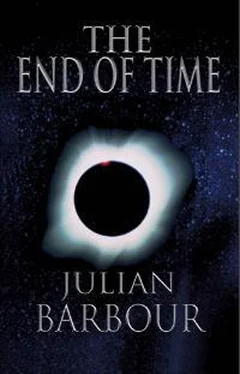As explained in the Preface, I start with three chapters in which I have attempted to present my main ideas with the minimum of technical details. The main aim is to introduce a definite way of thinking about instants of time without having to suppose that they belong to something that flows relentlessly forward. I regard instants of time as real things, identifying them with possible instantaneous arrangements of all the things in the universe. They are configurations of the universe. In themselves, these configurations are perfectly static and timeless. But how and why can something static and timeless be experienced as intensely dynamic and temporal?
That is what I hope to explain in simple terms in these first three chapters.
CHAPTER 1
The Main Puzzles
THE NEXT REVOLUTION IN PHYSICS
Nothing is more mysterious and elusive than time. It seems to be the most powerful force in the universe, carrying us inexorably from birth to death. But what exactly is it? St Augustine, who died in AD 430, summed up the problem thus: ‘If nobody asks me, I know what time is, but if I am asked then I am at a loss what to say.’ All agree that time is associated with change, growth and decay, but is it more than this? Questions abound. Does time move forward, bringing into being an ever-changing present? Does the past still exist? Where is the past? Is the future already predetermined, sitting here waiting for us though we know not what it is? All these questions will be addressed in this book, but the biggest remains the one St Augustine could not answer: what is time?
Curiously, physicists have tended not to ask this question, preferring to leave it to philosophers. The reason is probably the colossal and dominating influence of Isaac Newton and Albert Einstein. They shaped the way physicists think about space, time and motion. Each created a representation of the world of unsurpassed clarity. But having seen their way to a structure of things, they did not bother unduly about its foundations. This creates potential for confusion. Without question, their theories contain wonderful truths, but they both take time as given. It is a building block on a par with space, a primary substance. In fact, Einstein fused it with three-dimensional space to make four-dimensional space-time. This was one of the great revolutions of physics (Box 1).
BOX 1 The Great Revolutions of Physics
1543: The Copernican Revolution. In On the Revolutions of the Celestial Spheres , Nicolaus Copernicus proposed that the Earth moves around the centre of the universe. The modern meaning of revolution derives from his title. He established the form of the solar system. Curiously, the Sun plays little part in his scheme; he merely placed it near the centre of the universe. About sixty years later Johannes Kepler showed that the Sun is the true centre of the solar system, and with Galileo Galilei he prepared the way for the next revolution.
1687: The Newtonian Revolution. In The Mathematical Principles of Natural Philosophy , Newton formulated his three famous laws of motion and the theory of universal gravitation. He showed that all bodies – terrestrial and celestial – obey the same laws, and thus set up the first scheme capable of describing the entire universe as a unified whole. Newton created the science of mechanics, now often called dynamics, which ushered in the modern scientific age. He claimed that all motions take place in an infinite, immovable, absolute space and that time too is absolute and ‘flows uniformly without relation to anything external’.
1905: The Special Theory of Relativity. In a relatively short paper on electro-magnetism, Einstein showed that simultaneity cannot be defined absolutely at spatially separated points, and that space and time are inextricably linked together. What appears as space and what appears as time depends on the motion of the observer. He made startling predictions about the behaviour of measuring rods and clocks, and found his famous equation £ = mc2 . In 1908 Hermann Minkowski formalized the notion of space-time as a rigid, indissoluble, four-dimensional arena of world events.
1915: The General Theory of Relativity. The special theory of relativity describes a world without gravitation. After an eight-year gestation, Einstein finally formulated his general theory of relativity in which the rigid arena of Minkowski’s space-time is made flexible, responding to the presence of matter in it. Gravity is given a brilliantly original interpretation as an effect of the curving of space-time. The theory showed that time can have a beginning (the Big Bang) and that the universe can expand or contract. Although to a remarkable degree it was a creation of pure thought, many predictions of this theory have now been very well confirmed. It describes the large-scale properties of matter and the universe as a whole.
1925/6: Quantum Mechanics. This gets its name because it shows that some mechanical quantities are found in nature only in multiples of discrete units called quanta. This is a distinctive difference from the theories of Newton and Einstein, which are now called classical (as opposed to quantum) theories. The first quantum effects were discovered and described on an ad hoc basis by Max Planck (1900), Einstein (1905) and Niels Bohr (1913), while a consistent quantum theory was found in two different but equivalent forms: matrix mechanics, by Werner Heisenberg (1925), and wave mechanics, by Erwin Schrödinger (1926). Paul Dirac also made outstanding contributions. Quantum mechanics describes the properties of light, especially lasers, and the microscopic world of atoms and molecules. It is the bedrock of all modern electronic technology, but its results are bafflingly counter-intuitive and raise profound issues about the nature of reality. It is also puzzling that theories of completely different structures are used to describe the macroscopic universe (classical general relativity) and microscopic atoms (quantum mechanics).
Revolutions are what make physics such a fascinating science. Every now and then a totally new perspective is opened up. But it is not that we close the shutters on one window, open them on another, and find ourselves looking out in wonder on a brand-new landscape. The old insights are retained within the new picture. A better metaphor of physics is mountaineering: the higher we climb, the more comprehensive the view. Each new vantage point yields a better understanding of the interconnection of things. What is more, gradual accumulation of understanding is punctuated by sudden and startling enlargements of the horizon, as when we reach the brow of a hill and see things never conceived of in the ascent. Once we have found our bearings in the new landscape, our path to the most recently attained summit is laid bare and takes its honourable place in the new world.
Today, physicists confidently, indeed impatiently, await the next revolution. But what will it be? In 1979, when, like Newton and Dirac before him, Stephen Hawking became the Lucasian Professor at Cambridge, he announced in his inaugural address the imminent end of physics. Within twenty years physicists would possess a theory of everything, created by a double unification: of all the forces of nature, and of Einstein’s general theory of relativity with quantum mechanics. Physicists would then know all the inner secrets of existence, and it would merely remain to work out the consequences.
Neither unification has yet happened, though one or both certainly could. (Hawking has recently said that his prediction still stands but that ‘the twenty years starts now’.) For myself, I doubt that would spell the end of physics. But unification of general relativity and quantum mechanics may well spell the end of time . By this, I mean that it will cease to have a role in the foundations of physics. We shall come to see that time does not exist. Though still only a prospect on the horizon, this, I think, could well be the next revolution. What a denouement if it is!
Читать дальше












